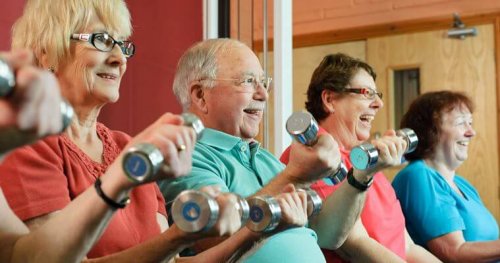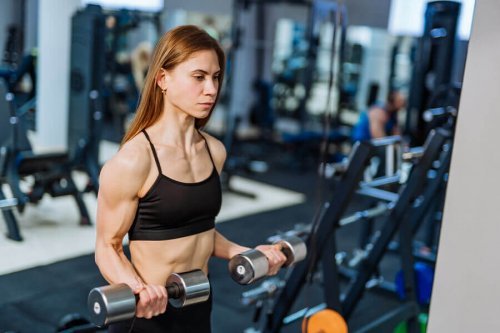How to do Strength Training Movements for Women Over 50

The degradation process and subsequent loss of muscle mass in humans begins at age 30. At age 65, this wear begins to accelerate and is even more noticeable in the female sex. However, strength training movements may be an option to slow it down.
In reality, stopping this process will depend on a mixture of exercises, diet, and lifestyle. In practice, the routines will go beyond performing aerobic exercises. Women who’ve never trained with weights will have a harder time, but it’ll certainly be worth it.
Strength training for the elderly: basics
Resistance exercises are not enough to stop muscle breakdown. In some cases, it can even encourage it. Only exercises that generate metabolic variations in the body will help stop this breakdown. Moreover, strength training movements will serve to control some important aspects of the body.
High-intensity exercises are much more beneficial, even for people over 60 years of age. We’re referring to exercises with a 70 – 80 percent proportion at 1MR (maximum repetition). Improving muscle mass at these ages also contributes to heart resistance and sugar in the blood.
Nonetheless, it’s a fact that the elderly have a difficult time completing strength training movements that are too demanding. Hence, they must start progressively and stop when they exceed their body’s limits. The exercise programs in these cases must be of high intensity and short in terms of duration.
Medical check-ups are also recommended for people who aren’t used to dealing with strength training. They should perform maximum and submaximal weight lifting tests. It’s necessary to be at the appropriate minimum physical state.

Starting gradually
It’s essential to understand that the incorporation of dumbbells is the best way to approach strength training. Among other things, dumbbells are manageable and can hold all kinds of weights.
At first, the weight must be relatively light, to accustom the body. The machines will also be your great allies.
Keep in mind that you can’t abandon aerobic routines. In fact, it’s best to divide the training between both facets: aerobic and anaerobic. You should always start by increasing your heart rate and resistance. The treadmill and bicycle are excellent options for this.
Likewise, warming up and stretching are essential at these ages since joints and muscles lose flexibility. Another important point is that the exercises should never be too anatomically complex. Strength training should begin with safe movements.
Strength training exercises for the elderly
These exercise routines are suitable for older people:
- Bicep curls: although it focuses on a small muscle, it contributes to promoting the arm’s muscle fiber maintenance. Its movement is very safe and simple to perform; by increasing the strength of the limbs, we can better address other routines.

- Supinated grip pulldown: in this exercise, the palms will point towards the body and the separation between both hands will be intermediate. The movement is also very simple and injuries are not likely to happen. The back is one of the largest muscle groups, so this workout suits you well.

- Lots of leg work: taking advantage of the previous aerobic exercises, the legs and thighs will be a good starting point. If it’s not possible to do squats, you can use almost all the machines in the gym.
- Machine bench press: loading a 44-pound bar plus weights can be difficult at an advanced age. Thus, you can choose to perform this exercise with a machine. The movement and weights will be much more controllable.

To wrap up
When a 60-year old person performs strength training, the goals can’t match those of a bodybuilder. In fact, there will be a maximum of three or four routines, with three or four sets. In comparison, a young person usually does six to eight exercises.
Likewise, you can’t set goals at an intermediate level. In truth, the progress will be much slower than it would be for a younger person. Mainly, it’s because it’ll be more difficult to gain weight or do more repetitions weekly. The idea is to work-out, of course, but according to each person’s capabilities.
Consistency will certainly be the most important factor. Everything must be accompanied by good nutrition and rigorous medical checks. You have a second chance, but it’ll be up to you. Age is only a number when there’s determination.
The degradation process and subsequent loss of muscle mass in humans begins at age 30. At age 65, this wear begins to accelerate and is even more noticeable in the female sex. However, strength training movements may be an option to slow it down.
In reality, stopping this process will depend on a mixture of exercises, diet, and lifestyle. In practice, the routines will go beyond performing aerobic exercises. Women who’ve never trained with weights will have a harder time, but it’ll certainly be worth it.
Strength training for the elderly: basics
Resistance exercises are not enough to stop muscle breakdown. In some cases, it can even encourage it. Only exercises that generate metabolic variations in the body will help stop this breakdown. Moreover, strength training movements will serve to control some important aspects of the body.
High-intensity exercises are much more beneficial, even for people over 60 years of age. We’re referring to exercises with a 70 – 80 percent proportion at 1MR (maximum repetition). Improving muscle mass at these ages also contributes to heart resistance and sugar in the blood.
Nonetheless, it’s a fact that the elderly have a difficult time completing strength training movements that are too demanding. Hence, they must start progressively and stop when they exceed their body’s limits. The exercise programs in these cases must be of high intensity and short in terms of duration.
Medical check-ups are also recommended for people who aren’t used to dealing with strength training. They should perform maximum and submaximal weight lifting tests. It’s necessary to be at the appropriate minimum physical state.

Starting gradually
It’s essential to understand that the incorporation of dumbbells is the best way to approach strength training. Among other things, dumbbells are manageable and can hold all kinds of weights.
At first, the weight must be relatively light, to accustom the body. The machines will also be your great allies.
Keep in mind that you can’t abandon aerobic routines. In fact, it’s best to divide the training between both facets: aerobic and anaerobic. You should always start by increasing your heart rate and resistance. The treadmill and bicycle are excellent options for this.
Likewise, warming up and stretching are essential at these ages since joints and muscles lose flexibility. Another important point is that the exercises should never be too anatomically complex. Strength training should begin with safe movements.
Strength training exercises for the elderly
These exercise routines are suitable for older people:
- Bicep curls: although it focuses on a small muscle, it contributes to promoting the arm’s muscle fiber maintenance. Its movement is very safe and simple to perform; by increasing the strength of the limbs, we can better address other routines.

- Supinated grip pulldown: in this exercise, the palms will point towards the body and the separation between both hands will be intermediate. The movement is also very simple and injuries are not likely to happen. The back is one of the largest muscle groups, so this workout suits you well.

- Lots of leg work: taking advantage of the previous aerobic exercises, the legs and thighs will be a good starting point. If it’s not possible to do squats, you can use almost all the machines in the gym.
- Machine bench press: loading a 44-pound bar plus weights can be difficult at an advanced age. Thus, you can choose to perform this exercise with a machine. The movement and weights will be much more controllable.

To wrap up
When a 60-year old person performs strength training, the goals can’t match those of a bodybuilder. In fact, there will be a maximum of three or four routines, with three or four sets. In comparison, a young person usually does six to eight exercises.
Likewise, you can’t set goals at an intermediate level. In truth, the progress will be much slower than it would be for a younger person. Mainly, it’s because it’ll be more difficult to gain weight or do more repetitions weekly. The idea is to work-out, of course, but according to each person’s capabilities.
Consistency will certainly be the most important factor. Everything must be accompanied by good nutrition and rigorous medical checks. You have a second chance, but it’ll be up to you. Age is only a number when there’s determination.
All cited sources were thoroughly reviewed by our team to ensure their quality, reliability, currency, and validity. The bibliography of this article was considered reliable and of academic or scientific accuracy.
- Sociedad Española de Geriatría. Guía de ejercicio físico para personas mayores. Extraído de: https://www.segg.es/media/descargas/Acreditacion%20de%20Calidad%20SEGG/CentrosDia/GU%C3%8DA%20DE%20EJERCICIO%20F%C3%8DSICO%20PARA%20MAYORES.pdf
- Consejo Superior de Deportes de España. Actividad física para el envejecimiento activo de personas mayores. Extraído de: http://www.planamasd.es/sites/default/files/programas/medidas/actuaciones/WEB-GUIA-MAYORES%20versi%C3%B3n%20publicaci%C3%B3n.pdf
This text is provided for informational purposes only and does not replace consultation with a professional. If in doubt, consult your specialist.








